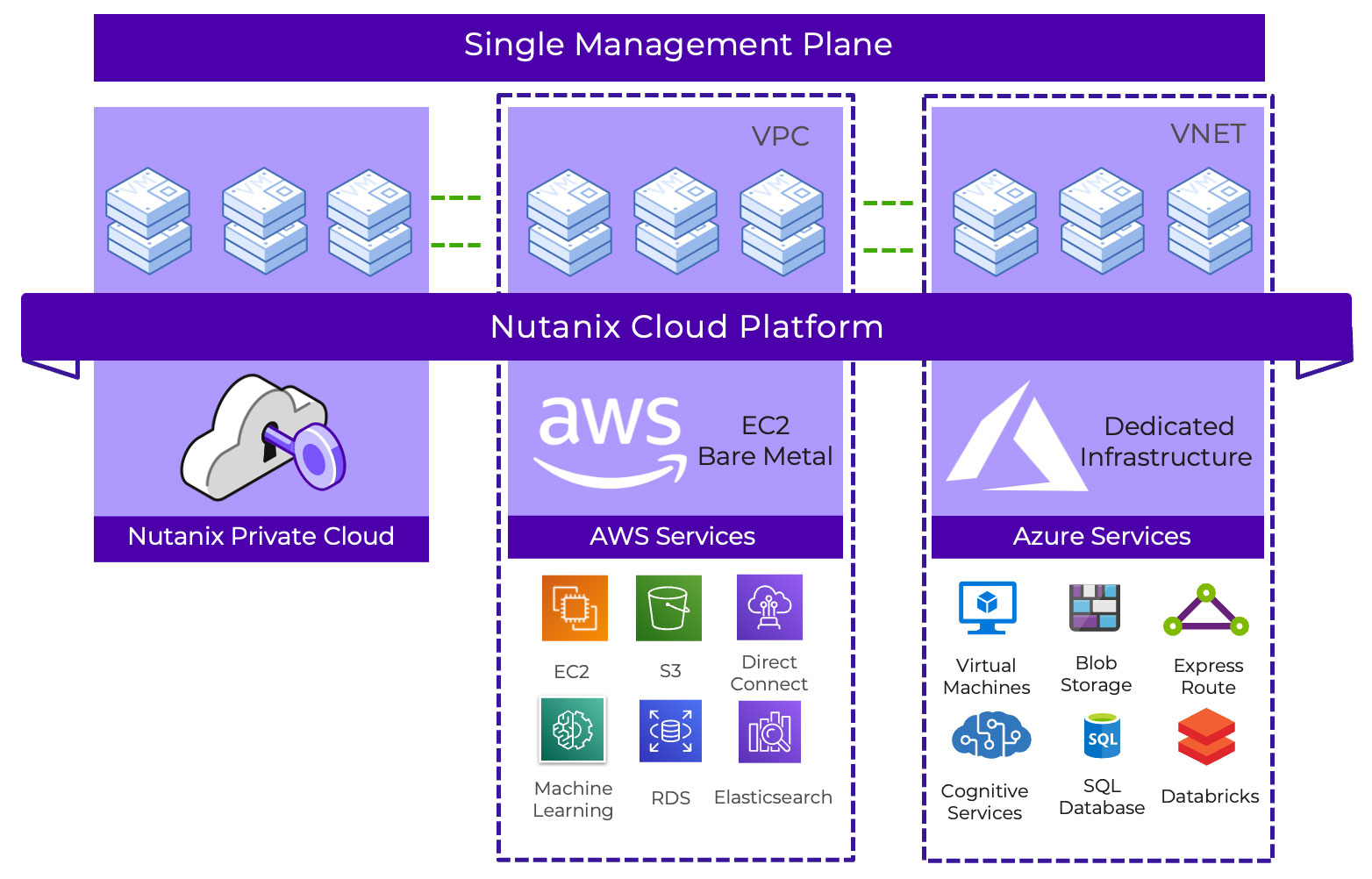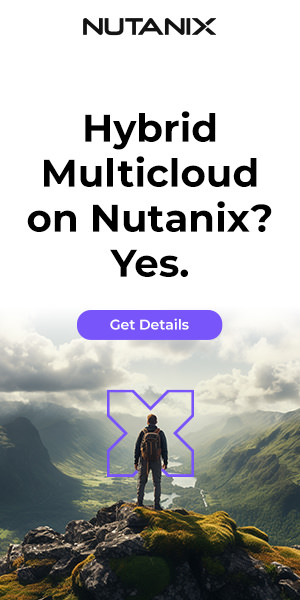Transforming Your Business With Nutanix: The Benefits of Adopting a Hybrid Multicloud Infrastructure
By Marc Trouard-Riolle
Businesses need to innovate to stay relevant, and IT is often called upon to balance new initiatives that transform their company’s business model, deliver innovative apps, and ensure everything is secured, all the while dealing with budget constraints, staffing shortages, and time pressures that make it challenging to stay ahead of the curve.
The solution? Build a hybrid cloud infrastructure on the Nutanix Cloud Platform™ solution and free your business from vendor lock-in to VMware and legacy infrastructure vendors while gaining the adaptability, security and a consistent operating model you need to thrive.
By knowing the various elements and core considerations that go into an effective hybrid cloud strategy, you can plan for a future where your business uses hybrid cloud technology to the fullest.
Key Takeaways:
- A comprehensive hybrid cloud strategy starts with the right cloud platform (sometimes referred to as a cloud operating system (OS) as the foundation.
- Modernizing on-premises legacy systems to match the new infrastructure provides a consistent operating model and maximizes hybrid cloud potential.
- Public clouds invariably make up a portion of any hybrid cloud environment, however choosing which provider to use should be based on several factors that align to the business and IT objectives, including platform capabilities, regional availability and cost.
What are the benefits of adopting hybrid multicloud infrastructure?
Hybrid multiclouds are made up of on-premises datacenter and edge environments (considered private clouds) and one or more public clouds. The proportional split between on-premises and public cloud environments will differ for every organization based on business need. It’s also important to note that hybrid multicloud is not the same as multi-[cloud]vendor, the latter of which simply implies more than one public cloud is in use, but without any consistency of IT operations.
A core benefit of hybrid multiclouds is that they enhance IT efficiency and business productivity by making it possible to leverage resources across multiple clouds. Business applications and data should be deployed where they are required and in the location that makes most sense, such as by placing applications and data close to their consumers.
Keeping predictable or high performance applications on-premises in a private cloud can help reduce overall cloud costs, while hybridizing with the public cloud grants IT agility and flexibility to access vast cloud computing power during times of high demand. This is when shifting workloads to optimize for change cost, seasonal demand, or performance needs can be invaluable.
The public cloud model is known for its agility, which grew in importance during the pandemic, supply chain disruptions and the search for IT talent. But the public cloud model is coming under scrutiny now that economic tightening is forcing customers to reevaluate cloud spend that can become surprisingly high. At a time when organizations are trying to keep up with changing dynamics by being more flexible, more agile, and overall trying to achieve more with less, leveraging a similar operating model across on-prem and public cloud environments will enable their IT teams to scale more efficiently.
The Nutanix® hybrid multicloud platform enables organizations to run applications in private clouds (datacenters and edge) or multiple public clouds, all operated as a single cloud. Its natively integrated networking between private and public clouds enables IT operators to seamlessly manage and migrate VMs, containers, and applications which makes it possible for an organization to pivot quickly in response to changing demands.

The benefits of using a hybrid cloud infrastructure include:
- Flexibility stemming from the simplicity of a consistent operating model with a common software stack across the cloud and single control plane minimizes infrastructure management silos and opens up the capability to simply move workloads between on-premises or cloud locations without modification.
- Convenience of end-user self-service via a marketplace-like environment leverages application automation for deployment, scale out and scale back on-demand.
- Time-to-value by speeding-up cloud adoption through the migration and deployment of existing applications and data.
- Total-Cost-of-Ownership savings through increased efficiency and elimination of resource micro-waste, dynamic cloud bursting, and flexible cost models that includes pay-as-you-go and portable Nutanix licenses between on-premises and cloud environments.
- Freedom from cloud lock-in by adding multiple clouds from multiple providers to your network and moving/deploying workloads across the hybrid cloud as required.
In a recent Enterprise Cloud Index survey, 94% of ECI respondents agreed with the statement that “one place to run and manage all applications and data across clouds is ideal for my organization.” This reveals the need for a robust cloud strategy to reap those benefits to make the hybrid multicloud environment work to its full potential.
Establish a cloud operating model as your framework
Cloud computing is only practically possible through technologies like virtualization and containerization that abstract servers’ hardware resources into many virtual machines (VMs) and/or containers. Cloud operating models automate the complex tasks of deploying, managing and operating VMs and their associated data simplifying the IT administration processes.
The Nutanix Cloud Platform, based on hyperconverged infrastructure (HCI) technology, provides a cloud operating model by normalizing the IT management processes across disparate locations and vendor platforms. Essentially, it enables organizations to monitor and manage their entire hybrid cloud environment with a single set of skills and toolsets. A consistent cloud operating model that can extend across on-premises and public clouds is foundational to a successful hybrid cloud journey.
The Nutanix approach creates an abstraction layer between the applications and data on one hand and their underlying hardware or cloud infrastructure on the other. This allows the applications and data to move easily between locations. This also benefits the administrator, who can seamlessly manage all applications in the environment from a single control plane.
Modernize your physical IT environment
Modernizing legacy infrastructure systems is an important step on the journey to a hybrid cloud infrastructure.
One solution is to modernize your datacenter environment with hyperconvergence, accommodating the transmission of data between on-premises storage and virtual cloud servers. With a hyperconverged infrastructure (HCI), you can also efficiently manage resources at any layer of the stack from a single pane.
Cybersecurity has become a key driver for organizations, but a barrier when considering datacenter modernization. Coordinating industry requirements, systems, and controls throughout various IT landscapes like on-premises datacenters and public clouds is a massive task. Nutanix breaks through these barriers to provide a consistent security model across both on-premises and public cloud deployments, simplifying security management, and helping develop strong cyber resilience to operate despite advanced persistent threats .
Choose the right public cloud to add to your environment
It is critical to understand driving factors for the addition of public cloud resources to your organization’s environment. These vary from business to technical decisions, such as the need to integrate with particular public cloud services or the desire to leverage existing public cloud credits. Cloud platform compatibility between on-premises infrastructure and the public cloud is a key consideration when selecting a framework.
Finding the right public cloud can be a simple matter of communication between your business and potential cloud service provider (CSP), aligning the functionality their cloud services can provide with your emerging hybrid cloud infrastructure.
It is equally important to consider the implications of individual services you might decide to integrate with your cloud environment. Note however, that integrating with CSP-specific cloud services APIs will likely result in cloud vendor lock-in which makes application mobility across the hybrid multicloud more difficult. Selecting which applications to integrate with cloud services can therefore be an important decision for your cloud strategy.
When modernizing your private cloud infrastructure, it's important to consider that the resulting environment will likely be a hyperconverged infrastructure (HCI). A determining factor in selecting a public cloud, therefore, might be the CSP’s capacity for extending the HCI software layer into its cloud platform.
Adopt the best hybrid cloud infrastructure solution with Nutanix
You need the right cloud framework as well as a modernization roadmap and public cloud solution that works well with that framework. Making the switch to the Nutanix hybrid multicloud model can satisfy those needs while also reinvigorating and even future-proofing your business.
The Nutanix Cloud Infrastructure™ (NCI) solution takes a standardized approach to hybrid cloud management. Nutanix layers software over each cloud and service location within a hybrid network and provides a consistent view of these disparate components such that they appear cohesive from a user’s perspective. You control this software layer and therefore control the entire network from a single, simple control plane but without the complexity of managing each layer or cloud location separately.
This empowers you and your business leaders to plan effectively for a future that uses hybrid multicloud infrastructure to the fullest.
© 2023 Nutanix, Inc. All rights reserved. Nutanix, the Nutanix logo and all Nutanix product, feature and service names mentioned herein are registered trademarks or trademarks of Nutanix, Inc. in the United States and other countries. Other brand names mentioned herein are for identification purposes only and may be the trademarks of their respective holder(s). This post may contain links to external websites that are not part of Nutanix.com. Nutanix does not control these sites and disclaims all responsibility for the content or accuracy of any external site. Our decision to link to an external site should not be considered an endorsement of any content on such a site. Certain information contained in this post may relate to or be based on studies, publications, surveys and other data obtained from third-party sources and our own internal estimates and research. While we believe these third-party studies, publications, surveys and other data are reliable as of the date of this post, they have not independently verified, and we make no representation as to the adequacy, fairness, accuracy, or completeness of any information obtained from third-party sources.
This post may contain express and implied forward-looking statements, which are not historical facts and are instead based on our current expectations, estimates and beliefs. The accuracy of such statements involves risks and uncertainties and depends upon future events, including those that may be beyond our control, and actual results may differ materially and adversely from those anticipated or implied by such statements. Any forward-looking statements included herein speak only as of the date hereof and, except as required by law, we assume no obligation to update or otherwise revise any of such forward-looking statements to reflect subsequent events or circumstances
